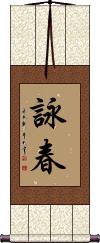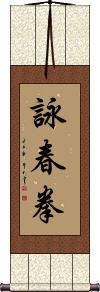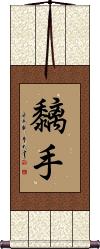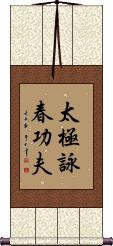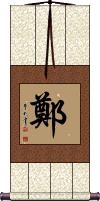Many custom options...
And formats...

Tsun in Chinese / Japanese...
Buy a Tsun calligraphy wall scroll here!
Personalize your custom “Tsun” project by clicking the button next to your favorite “Tsun” title below...
1. Wing Chun
Wing Chun
詠春 is a martial arts technique that has an oral history (versus a written one) so very little can be said for sure about its origins.
Wing Chun (or Wing Cheun) is a Chinese martial art that emphasizes short combat strokes.
The characters 詠春 literally mean “Singing Spring” (as in springtime).
If you are wondering, the spelling and pronunciation of this martial arts style in English come from the Cantonese pronunciation of these characters. The second character sounds similar in both Mandarin and Cantonese, but the first is quite different.
Note: This title can be pronounced in Japanese, but only a Japanese practitioner of Wing Chun would recognize or understand this title. It is not considered a Japanese word or martial art at all.
Lau Gar Kung Fu
Wing Chun Kung Fu
Wing Chun Fist
詠春拳 is the title for the “Wing Chun” school of martial arts but with the addition of the character for “fist” at the end. So this is “Wing Chun Fist” or literally “Singing Spring Fist.”
There are lots of alternate Cantonese romanizations for this, such as “Wing Chun Kuen,” “Wing Tsun Cheun,” “Eng Chun Pai,” and “Wing Ceon Kyun.” The characters are the same; just the lack of a standard Cantonese romanization means that people make up their own based on what they think it sounds like.
Sticky Hands / Chi Sau
The first character means “wood glue” or can be understood as “sticky” or “sticking.”
The second character means “hand” (or “hands”).
This term can be romanized as “Chi Sau,” “Chi Sao,” or from Mandarin, “Chi Shou.”
黐手 is a concept that comes from the Wing Chun (AKA: Ving Tsun, Wing Tsun, or Yong Chun) style of martial arts. If you are looking for this term, chances are, you already know the meaning within the context of Wing Chun.
Tai Chi Wing Chun Kung Fu
Zheng / Tei / Jeong / Trinh
Chinese Japanese Korean Vietnamese Surname
鄭 is the Chinese surname Zheng, Japanese surname Tei, Korean surname Jeong, and Vietnamese surname Trịnh.
This can also refer to the state of Zheng during the Warring States period of China.
In Korea, this can be the original way to write the surname Jeong in the old days (now it's 정 in modern Korea). Can also romanize from Korean as Chung or Jung.
In Japanese, this is the surname Tei. But can romanize as the following Japanese names/surnames: Ti; Te; Tsun; Dziyon; Chiyon; Chon; Chou; Chun; Chuu; Chien; Zen; Jiyon; Jon; Jou; Jun.
In Vietnamese, this is the name Trịnh from the time before Vietnam romanized the language.
Not the results for tsun that you were looking for?
Below are some entries from our dictionary that may match your tsun search...
| Characters If shown, 2nd row is Simp. Chinese |
Pronunciation Romanization |
Simple Dictionary Definition |
尊嚴 尊严 see styles |
zūn yán zun1 yan2 tsun yen |
More info & calligraphy: Dignity / Honor / Sanctity / Integrity |
尊師 尊师 see styles |
zūn shī zun1 shi1 tsun shih sonshi そんし |
More info & calligraphy: Respected Teacher(honorific or respectful language) holy master; guru |
尊敬 see styles |
zūn jìng zun1 jing4 tsun ching sonkyou / sonkyo そんきょう |
More info & calligraphy: Respect / Honor / Esteem(noun, transitive verb) respect; esteem; reverence; honour; honor; (given name) Sonkyō |
自尊 see styles |
zì zūn zi4 zun1 tzu tsun jison じそん |
More info & calligraphy: Self-Respect / Self-Esteemself-respect; esteem; self-importance; pride |
自尊心 see styles |
zì zūn xīn zi4 zun1 xin1 tzu tsun hsin jisonshin じそんしん |
More info & calligraphy: Prideful Mind / Self-Respecting Heartself-esteem; self-respect; self-importance; conceit; pride |
俊 see styles |
zùn zun4 tsun reishun / reshun れいしゅん |
(dialectal pronunciation of 俊[jun4]); cool; neat (obscure) excellence; genius; (given name) Reishun |
僔 see styles |
zǔn zun3 tsun |
to congregate; to crowd |
噂 see styles |
zǔn zun3 tsun uwasa うわさ |
talk together (n,vs,adj-no) rumour; rumor; report; hearsay; gossip; common talk; (surname) Uwasa |
墫 see styles |
zūn zun1 tsun ban ばん |
old variant of 樽[zun1] (surname) Ban |
尊 see styles |
zūn zun1 tsun mikoto みこと |
senior; of a senior generation; to honor; to respect; honorific; classifier for cannons and statues; ancient wine vessel (1) zun (ancient Chinese wine vessel, usu. made of bronze); (prefix) (2) (archaism) (honorific or respectful language) honorific prefix referring to the listener; (suf,ctr) (3) counter for buddhas; (female given name) Mikoto To honour. ārya; honoured, honourable. |
嶟 see styles |
zūn zun1 tsun |
(literary) (of terrain) steep; precipitous |
捘 see styles |
zùn zun4 tsun |
push |
撙 see styles |
zǔn zun3 tsun |
to reduce or cut down on; to rein in; to restrain |
樽 see styles |
zūn zun1 tsun ban ばん |
goblet; bottle; wine-jar cask; barrel; (personal name) Ban |
罇 樽 see styles |
zūn zun1 tsun |
variant of 樽[zun1] See: 樽 |
遵 see styles |
zūn zun1 tsun mamoru まもる |
to observe; to obey; to follow; to comply with (personal name) Mamoru To comply with, accord with, obey; accordingly. |
鐏 𨱔 see styles |
zūn zun1 tsun |
butt end of spear |
鱒 鳟 see styles |
zūn zun1 tsun masu ます |
trout; barbel; Taiwan pr. [zun4] (kana only) trout; sea trout; (surname) Masu |
三尊 see styles |
sān zūn san1 zun1 san tsun sanzon; sanson さんぞん; さんそん |
(1) (さんぞん only) {Buddh} Buddha triad; image of a Buddha attended by two Bodhisattvas; (2) (さんぞん only) {Buddh} (See 三宝) The Three Jewels; Buddha, the teachings of Buddha, and the community of monks and nuns; (3) (さんぞん only) (See 三尊天井) head and shoulders (stock price, etc. chart pattern); (4) the three people one must esteem: master, father, teacher The three honoured ones: Buddha, the Law, the Ecclesia or Order. Others are: Amitābha, Avalokiteśvara, and Mahāsthāmaprāpta, who, according to the Pure-land sect, come to welcome the dying invoker. Another group is Bhaiṣajya, Vairocana, and Candraprabha; and another, Śākyamunī, Mañjuśrī, and Samantabhadra. |
上尊 see styles |
shàng zūn shang4 zun1 shang tsun jōson |
supreme |
不尊 see styles |
bù zūn bu4 zun1 pu tsun fuson |
does not respect |
世尊 see styles |
shì zūn shi4 zun1 shih tsun seson せそん |
World Honored One; Revered One of the World (Buddha) World-Honored One (honorific name for Gautama Buddha) lokajyeṣṭha, world's most Venerable, or lokanātha, lord of worlds. 盧迦委斯諦; 路迦那他 World-honoured, an epithet of every Buddha. Also a tr. of Bhagavat, v. 婆. |
中尊 see styles |
zhōng zūn zhong1 zun1 chung tsun chuuzon; chuuson / chuzon; chuson ちゅうぞん; ちゅうそん |
{Buddh} (See 三尊・さんぞん・1,脇侍・きょうじ) central image (e.g. in a Buddha triad) The central honored one— in any group of Buddhas, e. g. 不動尊 among the five 明王. |
九尊 see styles |
jiǔ zūn jiu3 zun1 chiu tsun kuson |
The nine honoured ones in the eight-petalled hall of the Garbhadhātu, i.e. Vairocana in the centre of the lotus, with four Buddhas and four bodhisattvas on the petals, the lotus representing the human heart; v. 五佛. |
二尊 see styles |
èr zūn er4 zun1 erh tsun nison |
The two honoured ones, Śākyamuni and Amitābha. |
人尊 see styles |
rén zūn ren2 zun1 jen tsun ninson |
idem 人中尊.; The Honoured One among or of men, the Buddha. |
仁尊 see styles |
rén zūn ren2 zun1 jen tsun ninson |
Benevolent and honored, or kindly honored one, i. e. Buddha. |
仙尊 see styles |
xiān zūn xian1 zun1 hsien tsun senson |
leader |
令尊 see styles |
lìng zūn ling4 zun1 ling tsun |
Your esteemed father (honorific) |
佛尊 see styles |
fó zūn fo2 zun1 fo tsun busson |
the Buddha |
Click here for more tsun results from our dictionary
The following table may be helpful for those studying Chinese or Japanese...
| Title | Characters | Romaji (Romanized Japanese) | Various forms of Romanized Chinese | |
| Wing Chun | 詠春 咏春 | ei haru / eiharu | yǒng chūn yong3 chun1 yong chun yongchun | yung ch`un yungchun yung chun |
| Lau Gar Kung Fu | 劉家功夫 刘家功夫 | liú jiā gōng fu liu2 jia1 gong1 fu liu jia gong fu liujiagongfu | liu chia kung fu liuchiakungfu |
|
| Wing Chun Kung Fu | 詠春功夫 咏春功夫 | yǒng chūn gōng fu yong3 chun1 gong1 fu yong chun gong fu yongchungongfu | yung ch`un kung fu yungchunkungfu yung chun kung fu |
|
| Wing Chun Fist | 詠春拳 咏春拳 | yǒng chūn quán yong3 chun1 quan2 yong chun quan yongchunquan | yung ch`un ch`üan yungchunchüan yung chun chüan |
|
| Sticky Hands Chi Sau | 黐手 | chī shǒu / chi1 shou3 / chi shou / chishou | ch`ih shou / chihshou / chih shou | |
| Tai Chi Wing Chun Kung Fu | 太極詠春功夫 太极咏春功夫 | tài jí yǒng chūn gōng fu tai4 ji2 yong3 chun1 gong1 fu tai ji yong chun gong fu taijiyongchungongfu | t`ai chi yung ch`un kung fu taichiyungchunkungfu tai chi yung chun kung fu |
|
| Zheng Tei Jeong Trinh | 鄭 郑 | tei | zhèng / zheng4 / zheng | cheng |
| In some entries above you will see that characters have different versions above and below a line. In these cases, the characters above the line are Traditional Chinese, while the ones below are Simplified Chinese. | ||||
Successful Chinese Character and Japanese Kanji calligraphy searches within the last few hours...
